Speaking about the Ram temple consecration ceremony, the Bharatiya Janata Party (BJP) stalwart Lal Krishna Advani has played a crucial role in the Ram Janmabhoomi movement. And now, being a prominent face both in politics and in the Ayodhya movement and as a former RSS member, Advani is all set to attend the consecration ceremony of the Ram temple on January 22.
In this article, we’ll delve into how LK Advani played as the force behind the Ram Temple agitation, tracing his roots from his associated with RSS to the 1991 Rath Yatra of Karsevakas led by him.
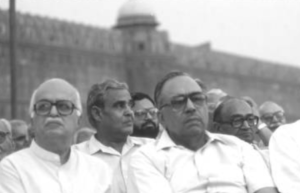
Rise of Advani in RSS
Advani’s association with Rashtriya Swayamsevak Sangh (RSS) began in 1941 at the tender age of 14. He joined the organization in his hometown of Karachi, then in British India. Advani’s dedication and leadership qualities quickly rose through the RSS ranks, becoming a full-time worker. He played a crucial role in expanding the RSS’s reach and influence in the region.
In 1947, after the independence, RSS saw an opportunity to influence national discourse. Advani became a key figure in the RSS’s political foray and joined Bharatiya Jana Sangh (BJS), the RSS political arm in 1951. Afterwards, he transformed the BJS into the BJP and served as the party’s president for several years. Moreover, his articulation of the Hindutva emphasizing Hindu pride and unity, resonated with a large section of Indian politics.
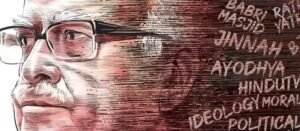
Stand of Advani on Hindutva
Advani had participated in the ‘Hindutva movement’ in the 1960s and 1970s and advocated for a Hindu-centric identity of India. As a co-founder of the Bharatiya Janata Party (BJP), Advani played a crucial role in bringing Hindutva into the mainstream. In one of his speeches in public, he stated the importance and the pride of Hinduism. He said, “If it is alright for Muslims to feel pride in Islam, and for Christians to feel pride in Christianity, why is it wrong for the Hindus to feel pride in Hinduism?”
Besides, he has also spoken out against religious violence and has been a vocal supporter of the Ram temple in Ayodhya, which is why he was well respected by the Hindu activists. Also, he advocated reforms like the abolition of untouchability and women’s empowerment.
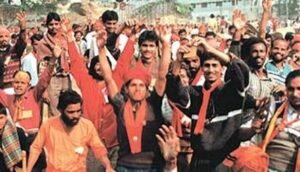
Respected by Kar Sevaks
Advani’s figure in Indian politics consisted of a range of responses from different segments of the population. With the Kar sevak community, opinions on him are rigid in high regard and harbor with reservations. His Hindu-centric ideology emphasises cultural revival and national identity and has resonated with many Kar Sevaks (Hindu activists) seeking a stronger Hindu voice in the national discourse.
Moreover, he championed taking care of various causes important to the kar sevaks, including the protection of Hindu temples, and the promotion of the Sanskrit language and culture, for which he was well respected by the sevaks. However, Advani’s rath yatra remains a defining moment for many kar sevaks.
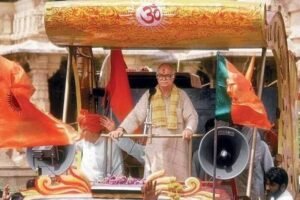
Rath Yatra for Ram Temple
LK Advani took out the “rath yatra” on September 25, 1990. He travelled in a modified rath (chariot) throughout the journey, addressing massive crowds along the way and advocating for the construction of the Ram temple. The yatra aimed to gather public support for the Ram temple movement and to put pressure on the govt to hand over the disputed site to the Hindu community.
The rallies were taken out from Gujarat to Uttar Pradesh, where Advani addressed the crowd with a major message. “Saugandh Ram Ki Khate Hain; Hum Mandir Wahin Banayenge,” he said. Afterwards, the yatra sparked communal tensions and led to the arrest of Advani, and the demolition of Babri Masjid in 1992, which widened the Hindu-Muslim divide. However, several legal developments were made and petitions were filed for the temple.
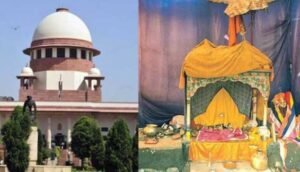
Petition filed in Court
Prime Minister P.V. Narsimha Rao acquired the entire disputed land in Ayodhya through the Acquisition of Certain Areas in the Ayodhya Act in 1993. This aimed to prevent further conflict. Following the conflict, both Hindu and Muslim parties filed title suits in Allahabad High Court, claiming ownership of the disputed site. Then, in 1992, after the demolition of Babri Masjid by Kar sevak, which sparked widespread riots. The central govt set up the Liberhan Commission to investigate the Babri Masjid demotion.
The Allahabad High Court delivered a verdict, with two judges favoring the construction of the Ram temple and one favoring for mosque, which made it complicated and taken forward by the Supreme Court in 2002. After that, from 2010-2019, the SC began hearing the Ayodhya title suits in 2010, with a lengthy legal battle with several hearings. And finally, in 2019, the SC awarded the disputed land to construct the Ram temple. After that, the construction started in 2020 and now it is on the verge of completion.
Ram Temple’s Completion & Advani as Prominent Audience
Advani’s association with the Ram temple movement has been central to the rise of Hindutva in Indian politics. His presence at the consecration ceremony could be seen as a major victory for his long-held beliefs and political struggles. Further, his presence in this mega event will not only symbolize a sense of closure for him but also further solidify its influence in the social and political landscape of India.












Comments 2